‘Mute’ button in conferencing apps may not actually mute your mic! The users of remote meeting software have typically a poor understanding of how the mute system works, falsely assuming that audio input is cut when they activate it. This is not always the case. You’re muted — or are you? Videoconferencing apps may listen even when mic is off and even transmit some of the audio to network.
A new study shows that pressing the mute button on popular video conferencing apps (VCA) may not actually work like you think it should, with apps still listening in on your microphone and in some cases even sending some of that audio to network. In the studied software, pressing mute does not prevent audio from being transmitted to the apps’ servers, either continually or periodically. This activity was not documented in related privacy policies.
It is quite natural in this type of applications that sound to go through a microphone to an application that’s authorized to do so at the operating system or browser level. When the “mute” setting is selected on the application means (should mean) that the application does not send audio to the network (the other party to the conference).
If you don’t trust the software you use, the next option is to try to prevent the audio from getting to the software in the first place so you can be sure that your audio does not get anywhere when you want to have your microphone muted. How the muting can be done depends on the microphone type and controls on it.
If there your microphone has a built-in on/mute switch, use it. If your microphone (for example Bluetooth microphones) has on power on/off switch, try to use it.
One way to mute audio is to put a physical breaker between the physical mic and the sound card. It works well what comes to the muting, but very often this engagement becomes a hard crackle and a bang when turned on and off. With a more complex connection with a circuit breaker and a couple of additional components, interference sounds that are caused by mute switch operation can be reduced to so low levels that they do not cause problems.
Sources:
‘Mute’ button in conferencing apps may not actually mute your mic
You’re muted — or are you? Videoconferencing apps may listen even when mic is off
USB and built-in microphone muting
To prevent privacy breaches and data theft, we recommend muting the microphone when not needed. Laptops come with an in-built mic with a dedicated microphone mute button. You can use the inbuilt microphone mute button inbuilt on your keyboard to disable it. The hotkey combination to unmute or mute microphone is Auto hotkey or Function key (F6) provided on all latest laptops. Alternately, the same can be enabled using third-party apps or coding macros.
However, there are a few other methods on how to mute microphone in Windows 10 which are sometimes needed. On desktops, you have to purchase microphones separately and there is not normally mic mute button or mic mute hotkey. How do I mute my USB microphone? Disabling the microphone through Windows Settings is a quick & easy method. You can also disable Microphone from device properties in sound setting
Muting on Windows 10 PC links:
https://www.addictivetips.com/windows-tips/mute-unmute-the-mic-with-a-keyboard-shortcut-on-windows-10/
https://sourceforge.net/projects/micmute/
https://www.top-password.com/blog/mute-or-turn-off-microphone-in-windows-10/
https://daron.blog/2020/mute-your-microphone-with-a-keyboard-shortcut/
https://techcult.com/how-to-mute-microphone-in-windows-10/
Video: How to Mute Mic with Keyboard Shortcut
PC electret mic
With traditional PC mic with 3.5 mm plug you can put a physical breaker between the physical mic and the sound card. You can unplug the microphone or you can just disconnect the signal carrying wire. Doing that the mute is taken care of, but very often this engagement becomes a hard crackle and a bang when turned on and off.
With a more complex connection with a circuit breaker and a couple of additional components, interference sounds are controlled. There are many plans for circuit and discussion on them in Internet:
http://www.discovercircuits.com/H-Corner/popfree%20micophone%20switch.htm
https://electronics.stackexchange.com/questions/272290/microphone-mute-anti-pop-circuit-works-but-still-picks-up-a-little-audio
https://electronics.stackexchange.com/questions/141499/5v-electret-microphone-to-pc-mute-switch-pop-help
https://electronics.stackexchange.com/questions/465044/3-5mm-push-to-talk-switch
http://www.next.gr/circuits/Microphone-Mute-circuit-l29101.html
I saw the following circuit on electronics.stackexchange.com that was mentioned in several discussions. The following circuit is designed to work with any electret microphone. Basically it shorts out only the AC (signal) by using a large capacitor but avoids switching the DC bias voltage which is the source of the pop.
When the mic is plugged in C1 experiences a step voltage (from the 5V supply/R2) which brings both terminals of the capacitor to the DC bias level of the electret. The negative terminal of the capacitor then discharges through R1 (100k) back to (nearly) 0 volts leaving no voltage across R1 (after more than 5 time constants). From the microphone’s perspective it ‘sees’ a parallel load of 100k (the impedance of the large capacitor being negligible). This 100 kohms load has no practical effect on the mic’s output. C1 is charged up to the bias voltage of the PC microphone, since R1 is in series with it, it limits the charge rate (and discharge rate) and softens what would be a very abrupt level change or “spike”
When the mute switch is operated (closed) there is no large DC step because the voltage across R1 is 0V and hence no large POP. The microphone now ‘sees’ only the 100uF capacitor as a load because the 100k has been shorted out. This effectively shorts out any AC (signal) and hence mutes the mic. The charged C1 is effectively an open circuit to the DC signal.
The circuit is not very critical in component values, so slightly higher capacitance values or somewhat lower resistance values can be used. Some component value combinations users have mentioned on discussion related to this circuit: 470uf 16v cap and a 10k resistor, 330uF and 100k resistor.
Here is screen capture from discussion at https://electronics.stackexchange.com/questions/272290/microphone-mute-anti-pop-circuit-works-but-still-picks-up-a-little-audio:
XLR mic mute
If your audio mixer or audio interface has a mute button, this is the easiest way to mute your XLR microphone. If you don’t have access to a mixer/interface with mute buttons, we recommend using an inline XLR mute switch. You plug your microphone’s XLR cable into the switch and connect the switch to your mixer/interface. There are different types of XLR mute switches available and a few things you need to look out for when buying one or building one. If you’re using a condenser microphone or other microphone that needs phantom power, you’ll want to ensure that the mute switch you select is phantom power-friendly.
There are two different types of mute switches.
The first one we’ll look at is called a cough mute button. This style of mute switch mutes the microphone when you’re holding the button down. This is ideal for quick, impulsive muting when you need to cough, sneeze, take a sip of water, or say something offline. However, it’s not ideal for an online meeting where you might have to hold the mute button down for minutes at a time.
A latch-style mute button works like a toggle switch. You click it on to mute the mic and click it off again when you’re ready to speak. This is better suited to the online meeting because the latch button keeps your hands free while the mic is muted.
In some applications it might be useful to have a push-to-talk (PTT) type mute switch, that passed the sound only when button is pressed.
Videos on XLR mic muting:
How To Mute An XLR Microphone
How to Mute a Microphone – Whirlwind Mic Mute
XLR Mic Mute Switch with LED (phantom powered)
If you want to make a DIY circuit, here are some ideas on those XLR mute circuits. Because XLR microphones typically use balanced circuits, for muting there are two signal wires that needs to be handled. One simplistic way is to use a double-pole relay or switch for hot and cold lines switching. Other in some cases recommended approach is to use a switch that just shorts pin 2 and 3. Those both approached will mute a mic, but they can cause still some level of popping to audio when switched on/off (especially when phantom power is turned on).
Microphone manufacturer Shure has published on their web page the following circuit ideas for noise free XLR microphone muting:
The page shows two circuit ideas. The first includes a potentiometer that neeeds to be adjusted case by case basis, which is not a very user friendly. There second circuit does not need any adjustments, so I consider it better. So from SHURE circuits I recommend this:
In the Shure circuit the capacitance value that needs to be used is 1000uF or 2200uF. Some other circuit seen on Internet show lower values down to about about 100uF, which can cause that at lowest frequencies the muting is not total, only some attenuation.
On-Stage Microphone Mute Circuit by Elliott Sound Products document shows the following circuit idea that shows also examples of the circuits you might expect to see on the both sides of mute box:
To mute the audio signal without disturbing phantom power a working solution is a direct short for audio signal between audio carrying wires. Because we don’t want to touch the DC potential (that can be somewhat different on different wires when phantom power powers microphone), audio signal shorting needs to be done using capacitance. A high value is necessary, because most mics have a fairly low output impedance, generally less than 200 ohms. Note that shorting the output of a microphone (whether dynamic or phantom powered) will cause no harm to 99.9% of microphones, because they require protection from the phantom power anyway. If you are concerned, contact the mic manufacturer to find out if it’s alright.
Links to some other plans and discussion:
Mic Mute Pedal – Phantom Power and LED
https://www.diyaudio.com/community/threads/mic-mute-pedal-phantom-power-and-led.339250/
Topic: xlr microphone mute
https://www.diystompboxes.com/smfforum/index.php?topic=109242.0
Couch box
https://i.imgur.com/LoHBRvw.jpg
Muting Circuits For Audio
https://sound-au.com/articles/muting.html
How can I make a phantom power mic popless mute switch?
https://electronics.stackexchange.com/questions/465265/how-can-i-make-a-phantom-power-mic-popless-mute-switch
Mic Mute Pedal – Phantom Power and LED
https://www.diyaudio.com/community/threads/mic-mute-pedal-phantom-power-and-led.339250/
XLR mute switch pedal with indicator
https://www.lutins.org/projects/
https://www.lutins.org/projects/xlr_schem.png
Other muting needs
An Automatic Mike Muter for Singing Guitarists document at http://www.geofex.com/article_folders/automike/automike.htm shows the following circuit ideas:
This picture shows several ways to mute a microphone. You can open up the signal line leading to the soundboard/PA by switching in a very high resistance, you can shunt the signal to ground for unbalanced lines or between the signal lines in a balanced system, or you can *both* open the signal line to the microphone *and* shunt the signals to ground on the PA side.
By itself, opening the signal line from the mike may not be a good idea, as the open cable leading to the PA may then pick up extraneous noise and hum. Likewise, a shunt arrangement will not leave you with additional hum, but may overload some active devices by shunting their output to ground. Combined series/shunt switching is the clear way to go. Those circuits should work pretty acceptably on the applications where it is guaranteed that there is only AC signal flowing on the wire and there is not DC potential on the wire, because that DC potential can cause lots of noise when you start switching the signal.
An Automatic Mike Muter for Singing Guitarists document shows this way how to use a relay with change-over switch to do both disconnecting and shorting to ground.
The An Automatic Mike Muter for Singing Guitarists document shows also several mute other circuit ideas for applications where there is no DC on the audio line to cause switching noise. If there is DC presents on the line, you need to use the capacitor and resistor methods as used on the OC electret microphone and XLR microphone muting.

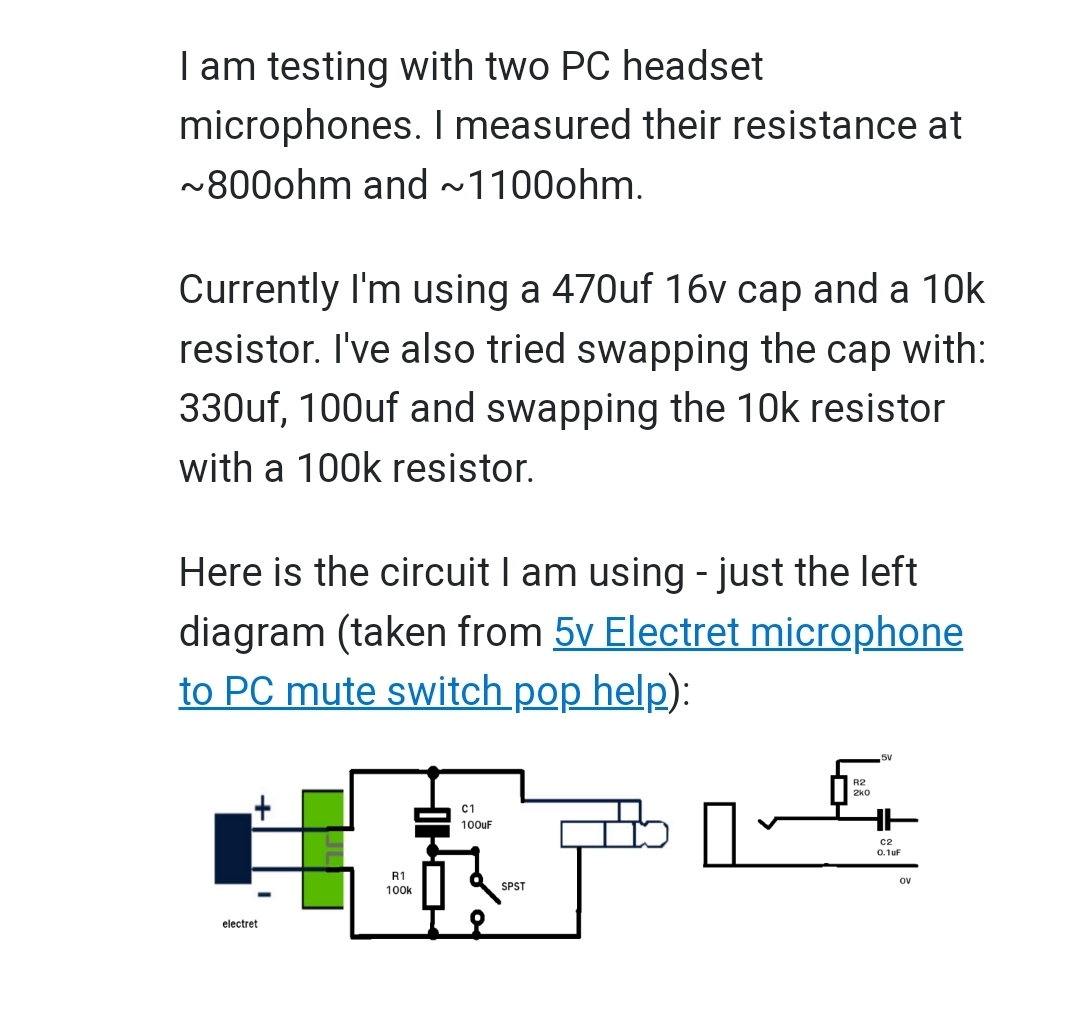
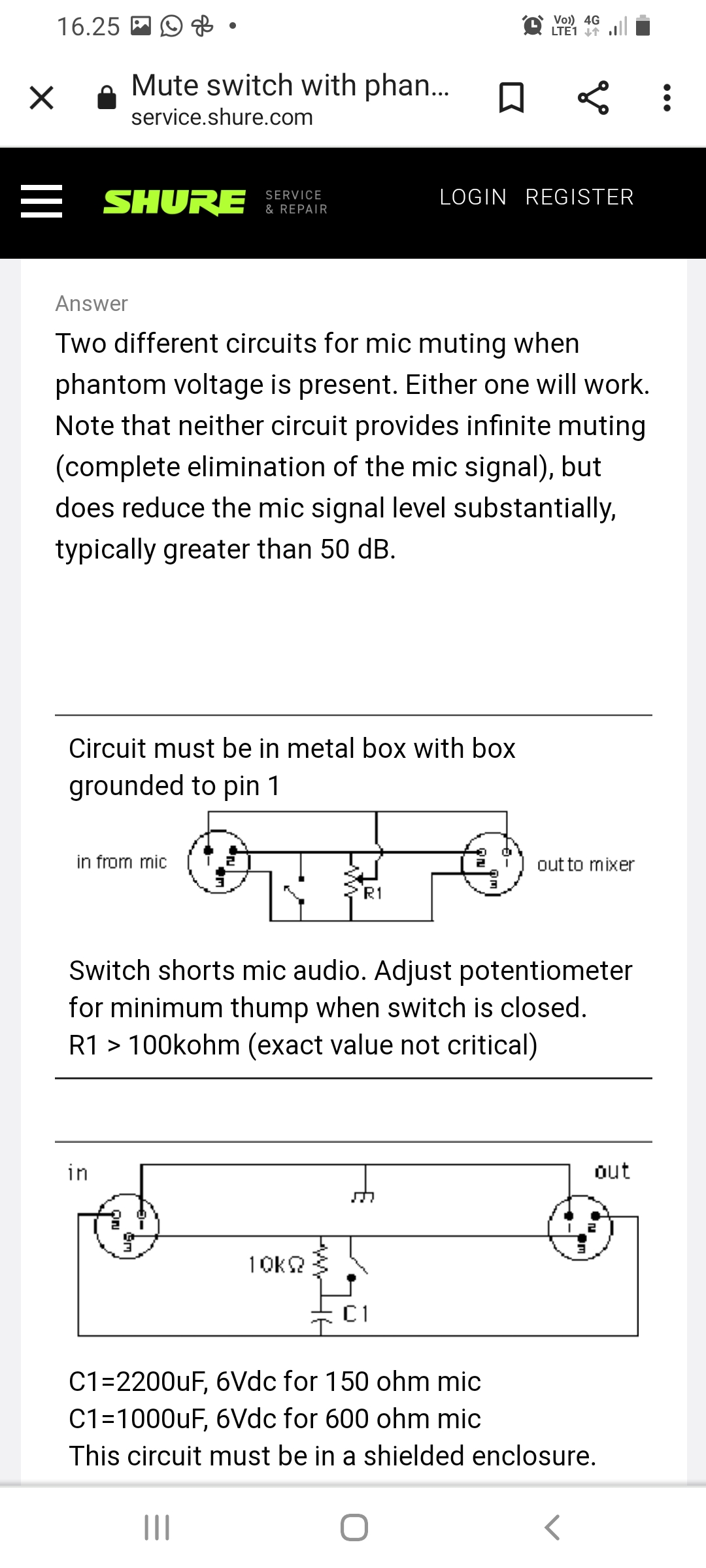
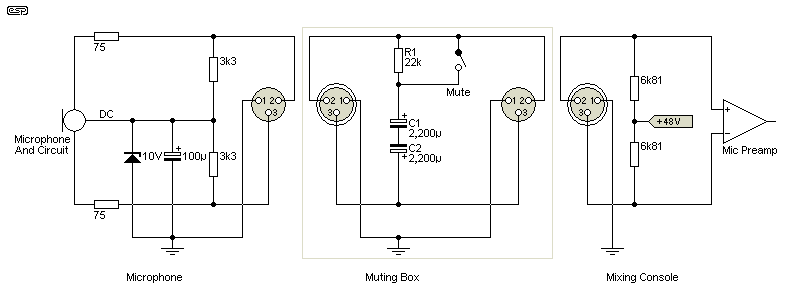
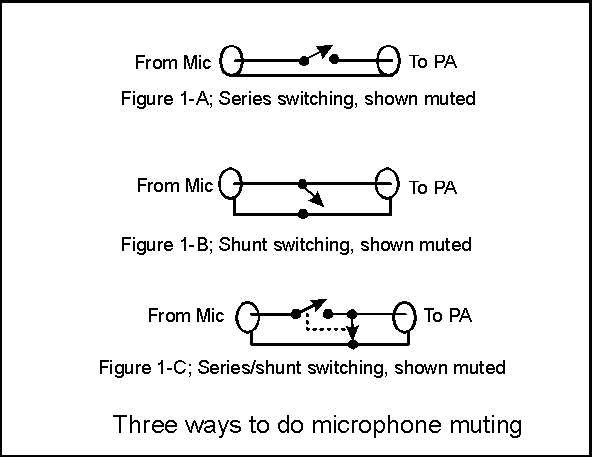
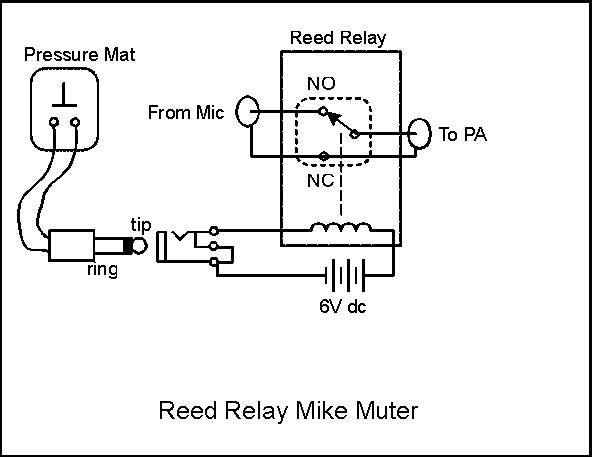
6 Comments
Truvic Online says:
Thanks, for such a great post. I have tried and found it really helpful. I always prefer to read the quality content and this thing I found in you post. We are also providing Managed IT service.
Aaron Reed says:
I’m wildly annoyed by microphones in which there is no mute button. This became a real problem during the times of covid when all the employees of our company https://writemyessaysos.com/pay-for-homework/ were transferred home. And on general calls there were constant extraneous noises.
Tomi Engdahl says:
Ideas for XLR muting when it’s not a mic but a music signal:
Using a DPDT switch, open (disconnect) pin 2&3 that feeds the input and simultaneously short the pins connected to input you are driving.
lee says:
I have a mic in a 3.5 port that sudden started picking up audio with the switch slider on mute.. its much lower but still pics it up… has my headset jacks power output been modified to overcome the physical mute.. and if so.. can i simply replace a component inside the switch with a larger one.. or heck.. if im breaking it open.. i could just use a fuse hahaha.. prolly look janky.. but unless there is insane high volatge at high frequency there is no bypassing an air gap lol.
David says:
It was exciting to visit this post, I learned a lot. The information on what-is-the-difference-between-a-signature-stamp-and-an-electronic-signature was worth reading. It had interesting facts.
herry says:
I was very obbessed about my signature from my childhood but was not able to make a satisfying signature. Now a website tells about what is airslate.com/product/pdf-editing and then I created an account and made a very attarcting signature for myself. i also suggest everybody to use this to create an amazing sign.